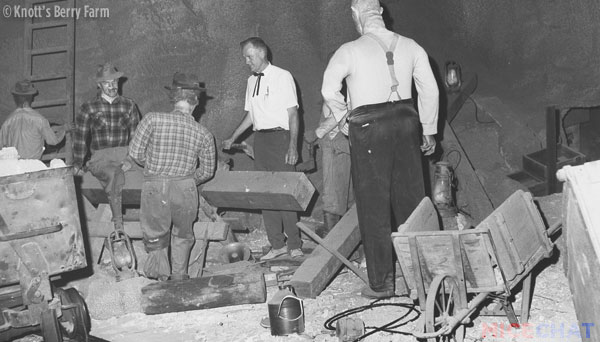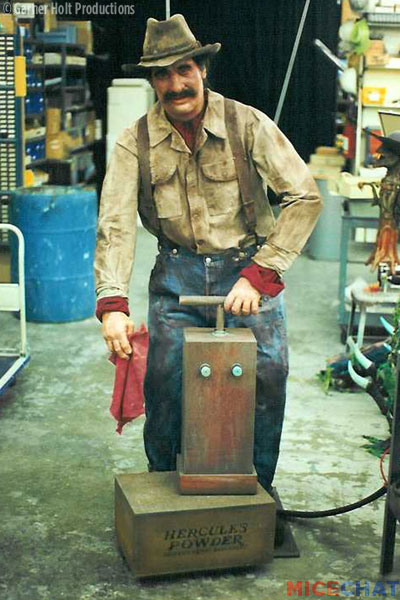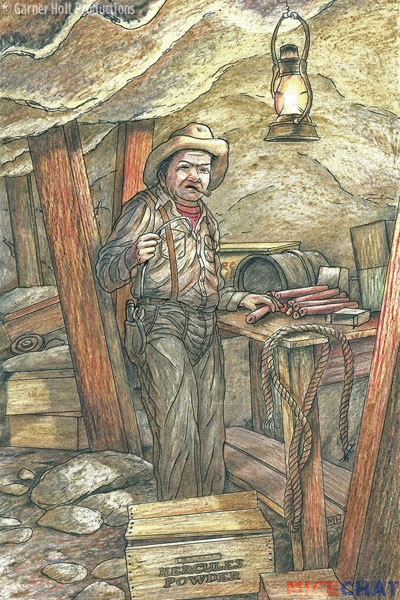Howdy—and welcome to the latest This Animatronic Life, the “not-as-frequent-as-I’d-like-but-genuinely-tries-to-be-semi-regular” column about the history of animatronics technology, themed entertainment, and Garner Holt Productions, Inc.’s (GHP) place in the story! Since the last update, we’ve been enormously busy here, with all sorts of projects for new and returning clients: Mattel, Disney, Knott’s Berry Farm, Lowes Foods, and more. In fact, this year alone, we’ve already had more than a dozen openings for our work in various attractions, shopping venues, museums, and other locations all over the country, plus lots of international development work still in the beginning stages of our creative process. There’s always something new and fantastic going on here at GHP.
The most visible of these projects—and I think the most meaningful and fun this year—is the recent reopening the Calico Mine Train attraction at Knott’s Berry Farm. The historical importance of the attraction has been dissected countless times by more studious fans than I am, so I won’t give my own interpretation. The attraction has been important and inspirational to me since I first experienced it as a young child. The Mine Train and I are the same age (actually I’m a couple of months older), and I can distinctly remember my first trip through, sitting on my dad’s lap as we entered the dimly lit, winding corridors of the mountain—I thought it was a real mine! I think that’s one of Bud Hurlbut’s best accomplishments with the Mine Train: the conceit in the ride isn’t fantasy, it’s a representation of real history.
Many years later, when my own company was on its feet and making headway into theme parks and other projects, I was contacted by Dick Rohrbach, former head of facilities at Knott’s Berry Farm. He told me the park wanted to enhance the Mine Train with some new figures and scenes, to premiere in 1995. I jumped at the chance to be part of the project, and immediately got together with one of my artists to commit to paper ideas for new little scenes and characters, and enhancements to what was already there. By this time, Knott’s had purchased Bud’s attractions and other concessions within the park, and were fully in charge of their maintenance and operation. The park retained Bud as a consultant, and sought his creative input on ways to keep his masterpiece attractions—the Mine Train and Calico Log Ride—in top form.

Bud wasn’t able to do everything with the Mine Train that he wanted to for its original opening in November 1960. The expense of the massive steel and wood structure, covered in thousands of square feet of faux rockwork, intermixed with cascading waterfalls, the rail system, six electrically-powered miniature locomotives and their consists, plus the immersive scenic rockwork, props, and other details within the mountain itself—not to mention all the behind the scenes support equipment—did not leave Bud with many options for the figures within the authentic-looking mining scenes. In fact, the interior of the Mine Train on opening day was entirely static, with the exception of moving elevators, a swinging crate on a cable through the enormous “Glory Hole” scene, and a couple of other simple motorized gags. All the human figures stood frozen in time.

Bud took almost immediate steps to remedy this, and introduced to the Mine a series of mechanical effects in the first few years of its operation. Consisting of about a dozen new characters, Bud’s additions included miners standing and swinging picks into rock walls, kneeling to drive picks into rocks, or kneeling and swinging hammers. In addition to these, which were replicated two each in the Mine, the “Square Set Timber” scene received a couple of additional simple reactive figures attached to motorized moving props, like a brace and a hoist. All the new moving figures were still relatively simple reciprocating motor-driven characters, but they had clever mechanical designs that gave them each a series of distinct and lifelike movements. Over the following decades, Bud added new effects, improved the lighting and audio, and kept on the lookout for new ways to enhance the Mine Train experience for guests—often by traveling to the annual amusement industry tradeshow put on by the International Association of Amusement Parks (IAAP, now called IAAPA after the inclusion of “Attractions”).

The new additions to the attraction that GHP was contracted to create—after sharing our concept art with the park—were directly inspired by Bud. We were to create five new animatronic figures: two sawyers in the “Glory Hole” scene, an additional miner seated atop the beam the sawyers were working on, a new character assembling dynamite sticks at the mouth of the “Explosion Tunnel” scene (a similar scene existed from opening day at the very bottom of the “Glory Hole,” almost totally invisible to guests), and a figure with a plunger box warning guests of blasting going on down the tracks. Based on our designs for the characters, we sculpted new faces and bodies, created new costumes, and even wrote and recorded new audio for the figures. For the first time, these new characters in the Mine Train would actually address guests as they passed by.
We lavished lots of detail and care on the figures. I always adhere to a policy of giving my clients more than what they pay for—it’s definitely one of the reasons for my company’s longevity in this often very tricky field—and my particular fondness for the Mine Train made me want to be sure these figures were truly outstanding. They would also, I hoped, lead to additional work at Knott’s. As it turned out, the figures were a major hit with the park and guests, and further concepts for additions were presented, including some spectacular new effects for the “Explosion Tunnel” scene. Sadly, these enhancements were not to be—Knott’s began negotiations with Cedar Fair Entertainment Company, LP to sell the park to the amusement giant shortly after GHP’s figures were installed. The deal put an immediate end to all current show enhancement projects at the park.

Almost two decades later, an early evening phone call from Knott’s reunited GHP and the park, as I mentioned in my last column about our work on Bud’s other masterpiece, the Timber Mountain Log Ride. The result of that call was an early morning walk through of three attractions at the park: the closed Kingdom of the Dinosaurs, followed by the Calico Mine Train and Timber Mountain Log Ride. At first, Knott’s thought our first efforts would be for the Mine Train, but the focus was ultimately shifted to the Log Ride—the results of that project are pretty well known! Last summer, we again took a look at the Mine Train after the Log Ride was successfully up and running again. In a walk-through of the attraction with my creative team and our counterparts from the park, we made a thorough inventory of all the figures and mechanical effects then inside the attraction. From this list, we could determine which elements and figures would be a simple “one-for-one” replacement, and which called for a more thorough re-imagining.
The Mine Train posed a creative challenge entirely different from the Log Ride. The Log Ride features a number of rather large, open scenes, which allowed us to create the entirely new “North Woods/Campsite” and the finale “Hootenanny” scenes and to populate other scenes with new characters and vignettes. The Mine Train, on the other hand, has only two types of setting: large, grand views (the various “Glory Hole” views) and very tight, close up scenes. As a result, there were very few opportunities to create all new scenes—instead, we needed to come up with new characters to place in existing vignettes. The Mine Train also differs from the Log Ride in that the undisputed star of the Log Ride is the thrilling flume journey itself. The scenery and animation simply supports that thrill-ride foundation. The Mine Train’s ride system is much more sedate, placing the entire focus of the attraction on its show portions. With this in mind, my creative team began to think of the Mine Train as an evolving interlaced series of thematically linked vignettes, an unfolding experience without a central storyline, but a strong overarching theme filled with supporting scenes and characters, similar to Disneyland’s Pirates of the Caribbean. The real-life historical nature of the original Mine Train inspired us to look for new opportunities to introduce more references to mining’s rich history.

A concept GHP introduced to the Mine Train with our work in the early 1990s was that of characters in the attraction speaking to guests. Instead of riders passing through scenes where the miners seemed totally unaware of their presence, this conceit added realism and depth to characters, and made guests feel like they were part of an active, living environment. Our first addition to the Mine Train would reflect this concept—a “greeter” character just inside the first tunnel. The greeter, whose name is “Bud,” welcomes visitors into the Calico Mine and warns them about some of the dangers ahead. The figure is the most complex in the entire attraction and signals to riders right away that big changes have happened in the Mine!
Moving ahead, the “Bubbling Pots” scene would be enhanced with the re-introduction of real steam to the room. Our partners at Knott’s accomplished this with the installation of a modern industrial boiler behind the scenes, providing the warm, moist atmosphere to this incredible scene—the way Bud meant it to be. The scene is also the first place where the Knott’s team’s updated lighting efforts can be seen in the exceptional and colorful RGB LED fixtures sprinkled cleverly throughout the room.

The “Glory Hole” is the literal and scenic heart of the Mine Train, a scene truly alive with activity on four separate levels, and teeming with detail. The majority of the figures in the entire attraction are found here, and comprise a combination of original early 1960s mechanical figures, GHP’s work from the 1990s, and new figures. The location and role of each of the original static and limited animation figures in this scene was very carefully assigned by Bud, and made good use of surrounding props and sets. Respecting this, the majority of the figures in this scene are what we termed “one-for-one” replacements. We took the role, position, and general pose of original figures and built all-new animatronic versions to be placed more or less in the same location as their static forebears.
As in the Log Ride, the rudimentary construction of the original figures (rebar, chicken wire, wood, lathe, plaster, fiberglass) did not make them suitable for re-use. We replaced them with figures with steel frames, fiberglass body shells, and silicone masks and hands. Our designers assigned appropriate individual functions and motions to each character based on poses and roles in the scene, adding a great deal of movement to the previously largely static environment. For example, a miner on the “Glory Hole’s” second level raises his right arm and waves his hand to direct the winch operator at the very top of the scene, while turning and nodding his head. Beside him stands the first of the animals new to the Mine Train, a trusty donkey laden with mining tools.
I have always been impressed with the early mechanical figures in the attraction—I even wrote about them in a previous column. I was excited to refurbish them for use in the updated Mine Train. When we received the figures at the GHP shop, my admiration did not diminish. Where other moving effects and figures in the attraction became static over the years, the vast majority of these moving figures remained in service until the Mine Train was closed for refurbishment late in 2013. Every one of the figures was built using robust steel frames and featured exceptionally clever mechanisms. With a regimen of regular lubrication, the figures remained in operational condition for decades—in fact, most still had their original motors and rheostat motor controls, all in working order. Our refurbishment efforts for them required very little mechanical work, just some new bearings and other parts here and there, plus the addition of new figure finishing details like silicone masks and hands, and all-new costumes.
In the next segment, I’ll give more details about bringing Bud’s incredible Mine Train back to life—and the real-life adventure of designing and working and installing and programming in one of the most unusual show buildings in the world!


You must be logged in to post a comment.